#Devi Chandraghanta
Explore tagged Tumblr posts
Text

पिण्डजप्रवारुढा चंदकोपास्त्रैर्युता।
प्रसादं तनुते मह्यं चन्द्रघण्टेति विश्रुता।।
I worship Goddess Chandraghanta who is mounted on the best of animals (living on flesh), who is displaying a ferocious rage and is accompanied by various weapons. Please extend your grace on me, O Devi! You who are celebrated as Chandraghanta.
𝐂𝐇𝐀𝐍𝐃𝐑𝐀𝐆𝐇𝐀𝐍𝐓𝐀; Mata Chandraghanta symbolizes courage, grace, and protection in a woman's life. She encourages fearlessness, balance in adversity, and the ability to radiate inner peace while standing strong against injustice.
#navratri#Devi chandraghanta#chandraghanta#goddess Adishakti#hindublr#deviblr#khyati's moodboards and aesthetics
24 notes
·
View notes
Text
Happy Sharada Navaratri
Are you celebrating this Sharada Navaratri? This year the festival is held from Sunday, October 15th to Tuesday, October 24th, for the usual nine nights and ten days. The festival is celebrated in the Hindu month of Ashvin – the seventh month of the lunisolar Hindu calendar – and is considered as being an auspicious time of the year. On Navaratri, Hindus celebrate the goddess Durga‘s battles…

View On WordPress
#avatar#Brahmacharini#Chandraghanta#classical dance#Devi Maa Brahmacharini#Devi Maa Chandraghanta#Devi Maa Kalratri#Devi Maa Katyayani#Devi Maa Kushmanda#Devi Maa MahaGauri#Devi Maa ShailPutri#Devi Maa Siddhidatri#Devi Maa Skandamata#Durga#folk dance#Goddess Durga#Hindu#India#Indian Culture#Indian Tradition#Kalratri#Katyayani#Kushmanda#Mahagauri#Navaratri#Navdurga#pandal#Raffaello Palandri#Shailputri#Siddhidatri
35 notes
·
View notes
Text
చంద్రఘంటా Chandraghanta

_(05.10.24) ఇంద్రకీలాద్రిపై 3.వరోజు అమ్మవారి అలంకారము శ్రీ అన్నపూర్ణా దేవి 🌳🌳🌳🌳🌳🌳
నేడు విజయవాడ దుర్గమ్మ అన్నపూర్ణ దేవి అలంకరణలో దర్శనం ఇస్తారు.
అన్నం పరబ్రహ్మ స్వరూపం. సకల ప్రాణకోటికి జీవనాధారం అన్నం. అన్నపూర్ణ రూపంలో అమ్మ రసపాత్రను ధరించి దర్శనమిస్తుంది. ఆదిభిక్షువైన మహాశివునికి భిక్షపెట్టిన తల్లి అన్నపూర్ణ. ప్రపంచ సృష్టి పోషకురాలు అమ్మ అనే అంతరార్ధం ఈ అవతారికలో కనిపిస్తుంది. అమ్మ ధరించిన రసపాత్ర అక్షయశుభాలను అందిస్తుంది.
అన్నపూర్ణను ధ్యానిస్తే మేధాశక్తి వృద్ధి చెందుతుంది. మధుర భాషణం, సమయస్పూర్తి, వాక్శుద్ది, వాక్సిద్ధి, భక్తిశ్రద్ధలు, ఐశ్వర్యం కలుగుతాయి. #భక్తుని సకలసంపూర్ణునిగా అనుగ్రహిస్తుంది ఈ తల్లి. బుద్ధి ఙ్ఞానాలను ఈ తల్లి వరంగా ఇస్తుంది. పరిపూర్ణభక్తితో తనను కొలిచైన భక్తుల పోషణభారం ఈమె వహిస్తుందని అర్షవాక్యం.
అమ్మవారిని తెల్లని పుష్పాలతో పూజ చెయ్యాలి. " హీం శ్రీం, క్లీం ఓం నమోభగత్యన్నపూర్ణేశి మమాభిలాషిత మహిదేవ్యన్నం స్వాహా" అనే మంత్రాన్ని జపించాలి. అన్నపూర్ణ అష్టోత్తరం, స్తోత్రాలు పారాయణ చెయ్యాలి.
అమ్మవారికి కొబ్బరి అన్నం నైవేద్యంగా సమర్పించాలి.
శ్రీ అన్నపూర్ణా దేవి స్తోత్రము!
-
నిత్యానందకరీ వరాభయకరీ సౌందర్య రత్నాకరీ
నిర్ధూతాఖిల ఘోర పావనకరీ ప్రత్యక్ష మాహేశ్వరీ |
ప్రాలేయాచల వంశ పావనకరీ కాశీపురాధీశ్వరీ
భిక్షాం దేహి కృపావలంబనకరీ మాతాన్నపూర్ణేశ్వరీ 1
నానా రత్న విచిత్ర భూషణకరి ��ేమాంబరాడంబరీ
ముక్తాహార విలంబమాన విలసత్-వక్షోజ కుంభాంతరీ |
కాశ్మీరాగరు వాసితా రుచికరీ కాశీపురాధీశ్వరీ
భిక్షాం దేహి కృపావలంబనకరీ మాతాన్నపూర్ణేశ్వరీ 2
యోగానందకరీ రిపుక్షయకరీ ధర్మైక్య నిష్ఠాకరీ
చంద్రార్కానల భాసమాన లహరీ త్రైలోక్య రక్షాకరీ |
సర్వైశ్వర్యకరీ తపః ఫలకరీ కాశీపురాధీశ్వరీ
భిక్షాం దేహి కృపావలంబనకరీ మాతాన్నపూర్ణేశ్వరీ 3
కైలాసాచల కందరాలయకరీ గౌరీ-హ్యుమాశాంకరీ
కౌమారీ నిగమార్థ-గోచరకరీ-హ్యోంకార-బీజాక్షరీ |
మోక్షద్వార-కవాటపాటనకరీ కాశీపురాధీశ్వరీ
భిక్షాం దేహి కృపావలంబనకరీ మాతాన్నపూర్ణేశ్వరీ 4
దృశ్యాదృశ్య-విభూతి-వాహనకరీ బ్రహ్మాండ-భాండోదరీ
లీలా-నాటక-సూత్ర-ఖేలనకరీ విఙ్ఞాన-దీపాంకురీ |
శ్రీవిశ్వేశమనః-ప్రసాదనకరీ కాశీపురాధీశ్వరీ
భిక్షాం దేహి కృపావలంబనకరీ మాతాన్నపూర్ణేశ్వరీ 5
ఉర్వీసర్వజయేశ్వరీ జయకరీ మాతా కృపాసాగరీ
వేణీ-నీలసమాన-కుంతలధరీ నిత్యాన్న-దానేశ్వరీ |
సాక్షాన్మోక్షకరీ సదా శుభకరీ కాశీపురాధీశ్వరీ
భిక్షాం దేహి కృపావలంబనకరీ మాతాన్నపూర్ణేశ్వరీ 6
ఆదిక్షాంత-సమస్తవర్ణనకరీ శంభోస్త్రిభావాకరీ
కాశ్మీరా త్రిపురేశ్వరీ త్రినయని విశ్వేశ్వరీ శర్వరీ |
స్వర్గద్వార-కపాట-పాటనకరీ కాశీపురాధీశ్వరీ
భిక్షాం దేహి కృపావలంబనకరీ మాతాన్నపూర్ణేశ్వరీ 7
దేవీ సర్వవిచిత్ర-రత్నరుచితా దాక్షాయిణీ సుందరీ
వామా-స్వాదుపయోధరా ప్రియకరీ సౌభాగ్యమాహేశ్వరీ |
భక్తాభీష్టకరీ సదా శుభకరీ కాశీపురాధీశ్వరీ
భిక్షాం దేహి కృపావలంబనకరీ మాతాన్నపూర్ణేశ్వరీ 8
చంద్రార్కానల-కోటికోటి-సదృశీ చంద్రాంశు-బింబాధరీ
చంద్రార్కాగ్ని-సమాన-కుండల-ధరీ చంద్రార్క-వర్ణేశ్వరీ
మాలా-పుస్తక-పాశసాంకుశధరీ కాశీపురాధీశ్వరీ
భిక్షాం దేహి కృపావలంబనకరీ మాతాన్నపూర్ణేశ్వరీ 9
క్షత్రత్రాణకరీ మహాభయకరీ మాతా కృపాసాగరీ
సర్వానందకరీ సదా శివకరీ విశ్వేశ్వరీ శ్రీధరీ |
దక్షాక్రందకరీ నిరామయకరీ కాశీపురాధీశ్వరీ
భిక్షాం దేహి కృపావలంబనకరీ మాతాన్నపూర్ణేశ్వరీ 10
అన్నపూర్ణే సాదాపూర్ణే శంకర-ప్రాణవల్లభే |
ఙ్ఞాన-వైరాగ్య-సిద్ధయర్థం బిక్బిం దేహి చ పార్వతీ 11
మాతా చ పార్వతీదేవీ పితాదేవో మహేశ్వరః |
బాంధవా: శివభక్తాశ్చ స్వదేశో భువనత్రయమ్ 12
సర్వ-మంగల-మాంగల్యే శివే సర్వార్థ-సాధికే |
శరణ్యే త్ర్యంబకే గౌరి నారాయణి నమోஉస్తు తే 13
రచన: ఆది శంకరాచార్య -
సర్వేజన సుఖినోభావంత్
🌕🌕🌕🌕🌕🌕🌕🌕🌕🌕🌕🌕
🍀🌹🍀🌹🍀🌹🍀🌹🍀🌹 🍀🌹🍀🌹🍀🌹🍀🌹🍀🌹
ఈరోజు (05.10.24) శ్రీశైలంలో చంద్రఘంటా దుర్గా అలంకరణ 🌔🌔🌔🌔🌔🌔🌔🌔🌔🌔🌔🌔
చంద్రఘంటా దుర్గా , దుర్గాదేవి తొమ్మిది అవతారాల్లో మూడవ అవతారం. భక్తులు ఈ అమ్మ వారిని చంద్రఖండ , చండికా , రణచండీ అని కూడా పిలుస్తారు. చంద్రఘంటా అంటే అర్ధచంద్రా కారంతో , గంట కలగి ఉన్నది అని అర్ధం. నవరాత్రులలో పూజించే నవదుర్గల్లో మూడో అవతారమైన చంద్రఘంటా దేవి ధైర్యానికీ , శక్తికీ , తేజస్సుకూ ప్రతీకగా భక్తులు భావిస్తారు. ఆ���ె తన తేజస్సుతో పూజించినవారి పాపాలు , ఈతిబాధలు , రోగాలు , మానసిక రుగ్మతలు , భూత భయాలు దూరం చేస్తుంది.
పురాణ గాథ
శివుడు , పార్వతి దేవిని వివాహం చేసుకోవడానికి ఒప్పుకున్న తరువాత ఆమె ఎంతో సంతోషిస్తుంది. పార్వతీదేవి తల్లిదండ్రులైన మేనకా దేవి , హిమవంతులు కూడా పెళ్ళికి అంగీకరిస్తారు. పెళ్ళి రోజున శివుడు దేవతలతోనూ , మునులతోనూ , తన గణాలతోనూ , శ్మశానంలో తనతో ఉండే భూత , ప్రేత , పిశాచాలతోనూ తరలి విడిదికి వస్తాడు. వారందరినీ చూసి పార్వతి తల్లి మేనకాదేవి కళ్ళు తిరిగి పడిపోతుంది. అప్పుడు అమ్మవారు చంద్రఘంటాదేవి రూపంలో శివునకు కనిపించి , తమ కుటుంబం భయపడకుండా ఉండేలా తన వేషం మార్చుకోమని ఆయనను కోరుతుంది. అప్పుడు శివుడు రాజకుమారుని వేషంలో , లెక్కలేనన్ని నగలతో తయారవుతాడు. అప్పుడు ఆమె కుటుంబసభ్యులు , స్నేహితులు , బంధువులూ భయం పోయి శివుణ్ణి వివాహానికి ఆహ్వానిస్తారు. ఆ తరువాత శివ , పార్వతులు వివాహం చేసుకుంటారు. అలా ప్రజల భయాన్ని పోగొట్టేందుకు అమ్మవారు మొదటిసారి ఇలా చంద్రఘంటా అవతారం ఎత్తింది.
శివ , పార్వతుల కుమార్తె కౌషికిగా దుర్గాదేవి జన్మించింది. శుంభ , నిశుంభులను సంహరించమని ఆమెను దేవతలు ప్రార్థించారు. ఆమె యుద్ధం చేస్తుండగా , ఆమె అందం చూసి రాక్షసులు మోహితులవుతారు. అమెను తన తమ్ముడు నిశుంభునికిచ్చి వివాహం చేయాలని శుంభుడు కోరుకుని ధూమ్రలోచనుణ్ణి కౌషికిని ఎత్తుకురమ్మని పంపిస్తారు. అప్పుడు అమ్మవారు తిరిగి చంద్రఘంటా దుర్గా అవతారం ధరించి ధూమ్రలోచనుణ్ణి , అతని పరివారాన్ని సంహరిస్తుంది. అలా శుంభ , నిశుంభులతో యుద్ధంలో నవదుర్గా అవతారాల సమయంలో రెండోసారి చంద్రఘంటా దుర్గా అవతారం ఎత్తింది అమ్మవారు.
రూప వర్ణన
చంద్రఘంటా దుర్గా దేవి ఎనిమిది చేతులతో ఉంటుంది. ఒక చేతిలో త్రిశూలం , మరో చేతిలో గద , ఒక చేతిలో ధనుర్భాణాలు , మరో చేతిలో ఖడ్గం , ఇంకో చేతిలో కమండలం ఉంటాయి. కుడి హస్తం మాత్రం అభయముద్రతో ఉంటుంది. చంద్రఘంటా దుర్గాదేవి పులి మీదగానీ , సింహం మీదగానీ ఉంటుంది . ఈ వాహనాలు ధైర్యానికి , సాహసానికీ ప్రతీకలు. అమ్మవారి కిరీటంలో అర్ధచంద్రుడు ఉండగా , ఫాలభాగంలో మూడో నేత్రంతో ప్రకాశిస్తుంది ఆ తల్లి. అమ్మవారు బంగారు వర్ణంలో మెరిసిపోతూంటుంది. శివుడు ఈ అమ్మవారి అందానికి ముగ్ధుడయ్యాడని పురాణోక్తి.
పులి లేదా సంహవాహిని అయిన అమ్మవారు ధైర్య ప్రదాయిని. నిజానికి ఈ రూపం కొంచెం ఉగ్రమయినా , ఆమె ఎల్లప్పుడూ ప్రశాంత వదనంతోనే ఉంటుంది. ఉగ్రరూపంలో ఉండే ఈ అమ్మవారిని చండి , చాముండాదేవి అని పిలుస్తారు.
ఈ అమ్మవారిని ఉపాసించేవారు మొహంలో దైవ శోభతో ప్రకాశిస్తుంటారని భక్తుల నమ్మికం. వారు అద్భు��మైన తేజస్సుతో ఉంటారట. ఈ అమ్మవారిని పూజించేవారు విజయాన్ని అతిశీఘ్రంగా పొందగలరని భక్తుల విశ్వాశం. దుష్టులను శిక్షించేందుకు ఈ అమ్మవారు ఎప్పుడూ తయారుగా ఉంటుందని పురాణోక్తి. అలాగే తన భక్తులకు ప్రశాంతత , జ్ఞానం , ధైర్యం ప్రసాదిస్తుందట ఈ అమ్మవారు. రాక్షసులతో యుద్ధం చేసే సమయంలో అమ్మవారి చేతిలోని ఘంట భీకరమైన శబ్దం చేసిందట. కొందరు రాక్షసులకు ఆ ఘంటానినాదానికే గుండెలవిసాయని దేవి పురాణం చెబుతోంది. అయితే ఈ ఘంటానినాదం ఆమె భక్తులకు మాత్రం శుభదాయకమనీ , ఎంతో మధురంగా వినపడుతుందని ప్రతీతి. దుష్టులకు అమ్మవారి రూపం ఎంత భయదాయకమో , ఉపాసకులకు మాత్రం అంత ప్రశాంతంగా కనిపిస్తుంది.
ధ్యాన శ్లోకం
పిండజ ప్రవరారూఢా చండకోపాస్త్రకైర్యుతా ప్రసాదం తనుతే మహ్యాం చంద్రఘంటేతి విశ్రుతా
🍇🍇🍇🍇🍇🍇🍇🍇🍇🪷🍇🪷
🍀🌹🍀🌹🍀🌹🍀🌹🍀🌹 🍀🌹🍀🌹🍀🌹🍀🌹🍀🌹
(05.10.24)బతుకమ్మ పండుగలో "నానబియ్యం బతుకమ్మ" 🦃🦃🦃🦃🦃🦃🦃🦃🦃🦃🦃🦃
తెలంగాణ సంస్కృతీ సంప్రదాయాలకు ప్రతీకగా నిలిచే బతుకమ్మ పండుగతో... రాష్ట్రమంతటా కోలాహలం నెలకొంది. మహాలయ అమావాస్య నుంచి దుర్గాష్టమి వరకు రంగురంగుల పూలతో బతుకమ్మను పేరుస్తారు. అచ్చమైన ఈ ప్రకృతి పండుగను తొమ్మిదిరోజుల పాటు జరుపుకుంటారు. తొమ్మిది రోజులు.. తొమ్మిది రూపాల్లో ఆ అమ్మవారిని పూజిస్తారు.
ఇవాళ నాలుగో రోజు సందర్భంగా... నానబియ్యం బతుకమ్మను చేస్తారు. నానేసిన బియ్యం , పాలు , బెల్లం కలిపి నైవేద్యంగా సమర్పిస్తారు.
నాలుగంతరాల బతుకమ్మ
తొమ్మిది రోజుల పాటు జరిగే ఈ వేడుకల్లో ఒక్కో రోజుది ఒక్కో ప్రత్యేకత. రోజుకో విధంగా గౌరమ్మను కొలుస్తూ... ప్రత్యేకమైన నైవేద్యాన్ని సమర్పిస్తారు.
నాలుగో రోజు నానబియ్యం బతుకమ్మగా కొలుస్తారు. తంగేడు, గునుగు , బంతి , చామంతి వంటి తీరొక్క పూలతో నాలుగంతరాల బతుకమ్మను పేరుస్తారు. శిఖరంపై పసుపుతో తయారుచేసిన గౌరమ్మను ఉంచుతారు. ఉదయం అమ్మవారికి పూజలు చేసి... సాయంత్రం వేళ గంగమ్మ ఒడికి చేరుస్తారు.
ఇవాళ నానపెట్టిన బియ్యాన్ని బెల్లం లేదా చక్కెరతో కలిపి ముద్దలుగా తయారు చేసి... పంచుతారు.
గంగమ్మ చెంతకు బతుకమ్మ
సాయంత్రం వేళ విశాలమైన ప్రదేశంలో తొలుత వెంపలి చెట్టును నాటి... దానిపై పసుపు కుంకుమను చల్లుతారు. అనంతరం బతుకమ్మలను ఆ చెట్టు చుట్టూ ఉంచుతారు. చిన్నాపెద్ద తేడా లేకుండా ఒకరి చేయి ఒకరు పట్టుకొని కోలాటాలు చేస్తారు. మరికొందరు చేతిలో రెండు కర్రలను పట్టుకొని కోలాటం చేస్తారు. బతుకమ్మ బతుకమ్మ ఉయ్యాలో... బంగారు బతుకమ్మ ఉయ్యాలో...., ఒక్కేసి పువ్వేసి చందమామ... ఒక్కజాములాయే చందమామ..., పసుపుల పుట్టింది గౌరమ్మా... పసుపుల పెరిగింది గౌరమ్మా... అంటూ చప్పట్లతో కష్టసుఖాలను తెలియజేసే జానపద పాటలు పాడుతారు. బంధాలు , బంధుత్వాలపైనా పాటలు పాడుతారు. చివరగా ఆ బతుకమ్మను గంగమ్మ ఒడికి చేర్చుతారు.
🌒🌒🌒🌒🌒🌒🌒🌒🌒🌒🌒🌒
#Devi Navaratri#Chandraghanta Devi#జ్ఞానవాహిని#Spiritual#Bhakthi#Insight#సందేశాలు#Jnanavahini#message of the day#prasad bharadwaj
0 notes
Text

Chandraghanta is the third navadurga aspect of goddess Mahadevi, worshipped on the third day of Navaratri . Her name Chandra-Ghanta, means "one who has a half-moon shaped like a bell". Goddess Chandraghanta is the married form the Goddess Parvati. After getting married to Lord Shiva Goddess Mahagauri started adorning her forehead with half Chandra and due to which Goddess Parvati was known as Goddess Chandraghanta.
D'Vine Yoga is starting a new batch from 1st November 2024 with 5% off in the green valley of Uttarakhand 'Rishikesh' Only a few seats left for November YTTC.
Hurry up! Grab the opportunity and book your slots now.
Contact Details ☎ Whatsapp: +919997224320 📞 Website: www.artdivine.org 🌐 Email: [email protected] 📩
#navratri#navratrispecial#garba#india#durgapuja#Rishikesh#jaimatadi#durga#festival#love#instagram#devi#maa#navratricollection#garbanight#durgamaa#hinduism#indianfestival#instagood#indian#dvineyoga#5%off#november#chandraghanta#offermonth
1 note
·
View note
Text
It's the final day of Navaratri, a 10 day, or 9 night, Hindu festival celebrating the 9 forms of the Goddess Durga. ✨Jai Durga Maa✨
Today though I figured I would post each of these forms here in one big post that celebrates each of her forms and victories over the past 10 days. I hope you enjoy.
Keep in mind there are many different traditions and versions of these myths, and I am not a Hindu, so your own research is always advised.
✨Shailputri✨
✨Om Devi Shailaputryai Namah✨
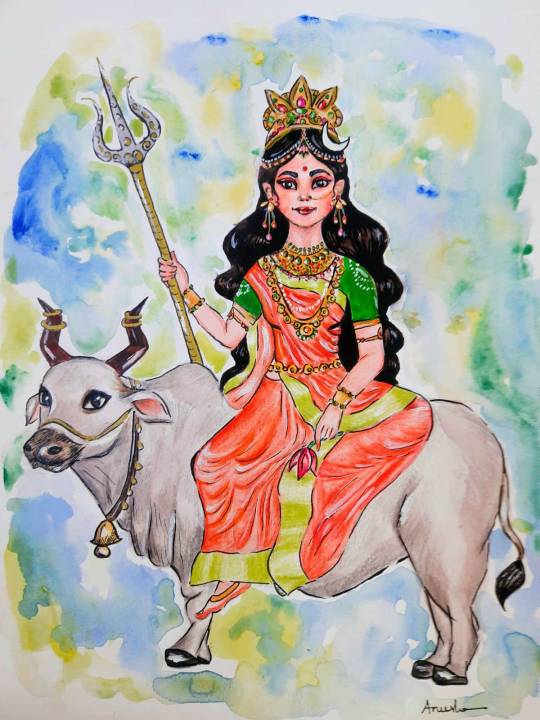
The first day of Navaratri celebrates Durga as Shailaputri, considered the absolute form of mother nature.
The colour of the day is yellow and she connects us to the root chakra, the foundation of Shakti.
She teaches patience, strength and grounding, keeping us firm in our beliefs. Meditating on her here represents the beginning stage of the journey to awakening, the first chakra activated when working with Kundalini. It is also said that the worship of Shailaputri on this day will ward off ill effects of the moon.
Her story goes as follows: Sati, also known as the daughter of the mountain, against her father's wishes becomes the wife of Lord Shiva. Not agreeing with Satis choice of partner, her father arranges a great party in which he invites all the gods, goddesses and holy men, everyone except Shiva and Sati. Upset and angry at this insult Sati crashes the party then throws herself into a fire, killing herself, later incarning as Parvati.
✨Brahmacharini✨
✨Om Braam Breem Broom Brahmcharinyai Namah✨
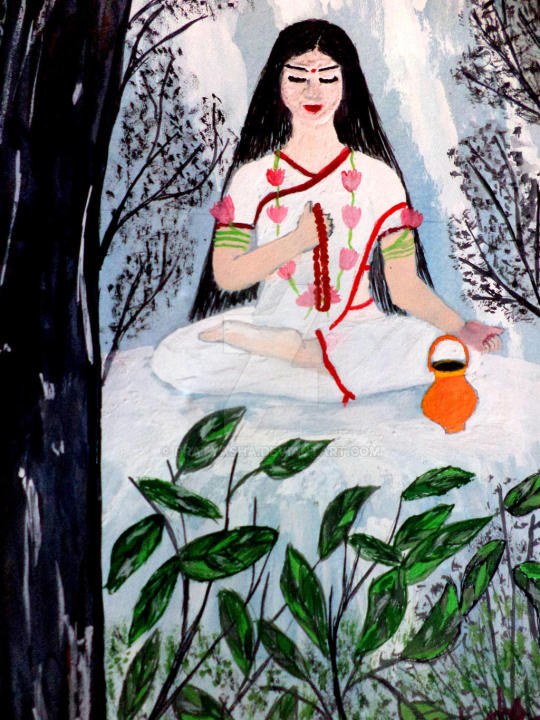
The second day of Navaratri celebrates Durga as Brahmacharini.
The colour of the day is green and she connects us to the Sacral Chakra.
She teaches perseverance, devotion, peace of mind, love and harmony. Meditating on her this day is said to bring the devotee victory in all their endeavors and the ability to persevere and stay balanced mentally in order to tackle any obstacles or duties that one faces.
Her story goes as follows: After Sati's death, Shiva goes into deep meditation that lasts for many many years, abstaining from all desires. Shiva, so deep in meditation, doesn't realise that Sati has reincarnated as Parvati. Parvati, wanting to marry Shiva once again in this life, is told that the only way she can marry him is if she undergoes a severe penance. Parvati then spends thousands of years in meditation, eventually eating, drinking and breathing nothing in devotion to Lord Shiva, in the hopes that he notices her and recognises her once more.
✨Chandraghanta✨
✨Om Hreem Kleem Shreem Chandraghantayai Namah✨
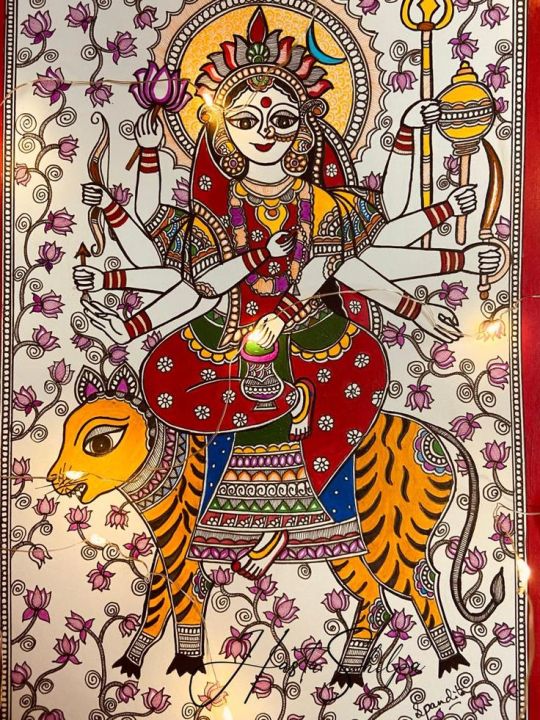
The third day of Navaratri celebrates Durga as Chandraghanta.
The colour of the day is grey and she connects us to the Solar Plexus.
She teaches justice, discipline, strength and power. Worship of her on this day is said to remove all evil spirits and obstacles, dispel sorrow and negativity and bring peace, grace and serenity to her devotees. She will also bless her devotees with a warrior spirit imbued with courage and might, so, like Chandraghanta, we are always confident and ready to fight for our own and others well-being.
Her story goes as follows: When Shiva is finally brought out of meditation and notices Parvati, he is happy with her devotion to him and agrees to marry her again. On the day of the wedding Shiva appears in his terrifying form, shocking and scaring the wedding guests. In response, and to ease the minds of the wedding guests, Parvati also changes herself into her terrifying form, Chandraghanta, and the two are wed.
✨Kushmanda✨
✨Om Hreem Kushmandayai Jagatprasootyai Namah✨
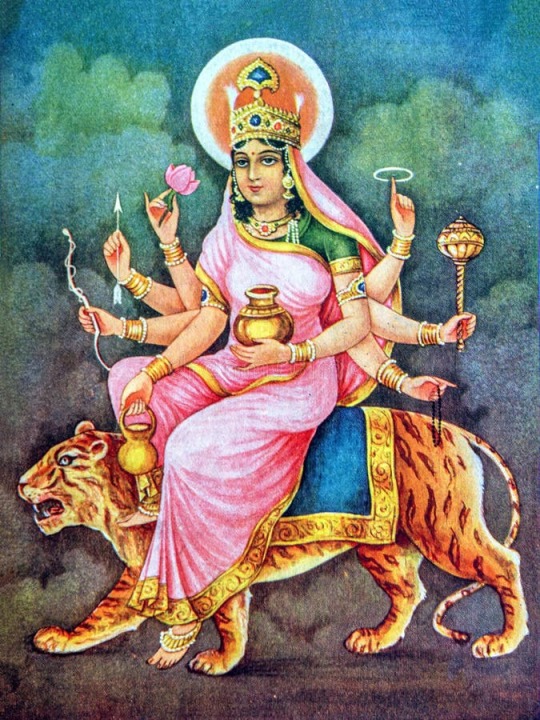
The fourth day of Navaratri celebrates Durga as Kushmanda, considered the creator of the universe.
The colour of the day is orange and she connects us to the Heart Chakra.
She teaches purification, clarity and creative energy. Worship of her on this day is said to remove planetary flaws and imbalances, purifies the darkness from bad actions or karmas, removes evil or negative energy, brings in good energy and a positive aura, sheds light on our path, promotes business which brings about success and opportunities, boosts creativity and concentration, builds harmonious relationships with others, and promotes good physical, mental and spiritual health.
Her story goes as follows: When the universe didn't yet exist and all was darkness, Kushmanda created the universe with her smile, filling the universe with light. She is believed to reside in the centre of the sun and embodies the source of all life. She created all the other gods, who go on to create other universes, beings and life forms.
✨Skandamata✨
✨Om Hreem Saha Skandmatryai Namah✨

The fifth day of Navaratri celebrates Durga as Skandamata, the mother of Skanda (also commonly known as Kartikeya), the commander-in-chief of the gods.
The colour of the day is white and she connects us to the Throat Chakra.
When we connect to Skandamata by proxy we also connect to Skanda, receiving both of their blessings.
Skandamata teaches us to nurture and protect children, have purity of intent and find ways to grow our knowledge. Worship of her on this day is said to promote fertility, prosperity, courage and wisdom. She blesses her devotees with a clear mind and a feeling of tranquility, she can pacify the heart and bring a life filled with contentment, prosperity and achievement for those with pure and selfless intentions, bringing many rewards. She will protect her devotees with a mothers love, giving them strength and power. It's also said that she can lead her devotees down the path of salvation, liberating them from the cycles of birth and death.
Her story goes as follows: When Shiva detached himself from all worldly affairs and went into deep meditation after the death of Sati, the demon Tarakasura was given a boon which only allowed the son of Shiva to kill him, and as such was free to wreak havoc. Parvati, after her severe penance was able to marry Shiva, and together they created an incredibly hot and fiery seed. Agni, the god of fire, was tasked with delivering the seed but the seed was far to hot. So Durga takes the form of water and carries the seed to a lake where Skanda is born. Skanda then goes on to become the commander-in-chief of the gods and fulfils his destiny, killing the demon Tarakasura.
✨Katyayani✨
✨Om Hreem Shreem Katyayanyai Namah✨
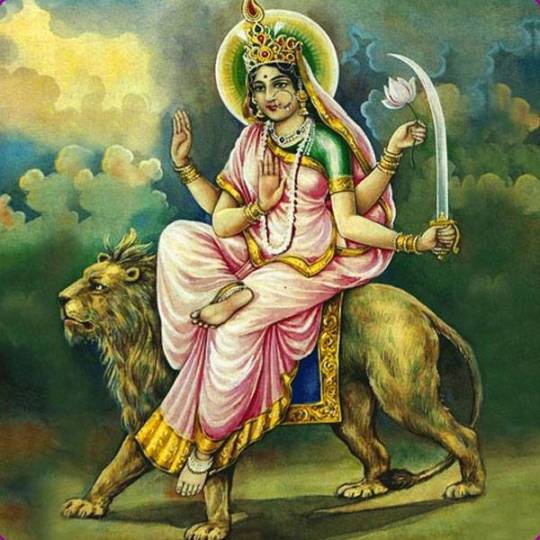
The sixth day of Navaratri celebrates Durga as Katyayani.
The colour of the day is red and she connects us to the Third Eye.
She teaches strength, protection and solutions to issues of love and marriage. Worship of Katyayani on this day is said to bring protection, remove evil spirits, triumph over obstacles, promote success and fame, bring love to those seeking, lead the way to a happy marriage, resolve problems in marriages and protect families. It is also said she will remove the negative powers of aspects in her devotees natal charts, as well as protect from malific planetary transits, remove sins and struggles that one faces, facilitating all round happiness and fulfilment.
Her story goes as follows: The trinity of the gods, Brahma, Vishnu and Shiva, among other gods, were so angry that the demon Mahishasura was wreaking havoc that their anger combined created Katyayani. They each gave her weapons and powers and tasked Katyayani to kill the demon. On her way to do this, Mahishasura was so captivated by her beauty he asked her to marry him, but Katyayani told him that she can only be won in a fight. Mahishasura, determined to win Katyayani's hand in marriage, changed into his bull form ready to fight, Katyayani on the other hand, jumped from her mount with such force she knocked him to the ground, killing him.
✨Kaalratri✨
✨Om Aim Hreem Shreem Kaalratryai Namah✨
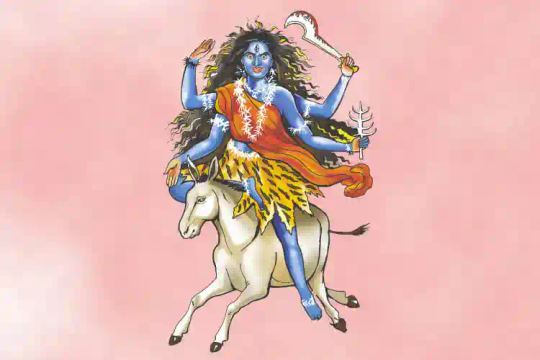
The seventh day of Navaratri celebrates Durga as Kaalratri, also known as Kali.
The colour of the day is royal blue and she connects us to the Crown Chakra.
Kaalratri is commonly known as the fiercest form of Durga, her mere image invokes fear in all those who do evil, she displays no mercy for the wicked. She teaches how to be bold, powerful and destroy ignorance and replace it with knowledge. Worship of her on this day is said to remove black magick and malevolent spirits of all kinds, they flee in terror when she is present. She removes fears, negativity and obstacles giving us the power to be bold, courageous and successful. She destroys ignorance and blesses her devotees with knowledge, wealth, power and good health. It is also said she will remove negative aspects in her devotees natal charts that relate to career, troubles with success or aspects that indicate health issues.
Her story goes as follows: The demon Raktabeej had a doon where every drop of blood would spawn yet another version of him, infuriating Parvati. As a result of her anger, Parvati changed into her Kaalratri form, turning her as dark as the night. Filled with rage she slaughters each of the forms of Raktabeej, collecting his blood in a bowl, and drinking it to stop him from multiplying. She did this until only the real Raktabeej was left, whereupon she chopped off his head and drank his blood until he was no more.
✨Mahagauri✨
✨Om Hreem Shreem Glaum Gam Gauri Geem Namah✨
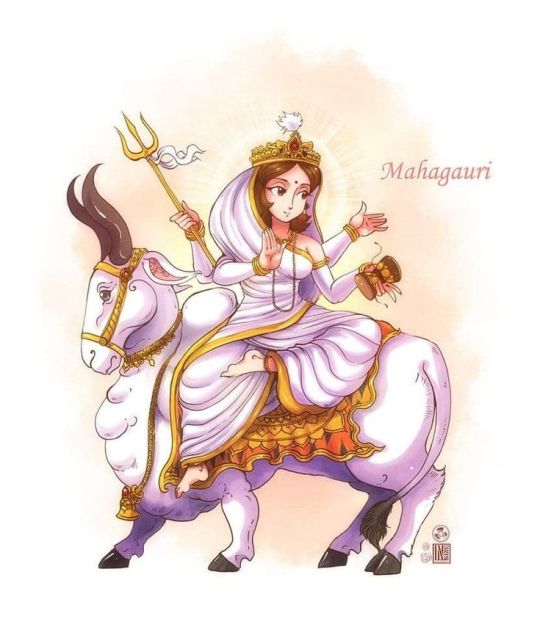
The eighth day of Navaratri celebrates Durga as Mahagauri.
The colour of the day is pink and she connects us to the Soul Star chakra, located just above the Crown Chakra.
Mahagauri teaches compassion, morality, and emotional stability. Worship of her on this day is said to remove impurities, dispel confusion, bring peace, facilitate compassion, lead the way to enlightenment, expand spiritual growth and fulfill desires. She blesses her devotees with a peaceful life, home and family, bringing a good partner to those who are seeking and bless marriages. She will also remove obstacles, negativity and the sins of her devotees, lead to self realisation and promote virtue and emotional stability.
Her story goes as follows: Parvati, after her battles as Kaalratri, was stuck looking as dark as the night, to regain her original form she was told to bathe in the river Ganges. Doing as recommended, she re-emerges from the river more beautiful than ever, as the glowing form of Mahagauri.
✨Siddhidatri✨
✨Om Hreem Shri Siddhidatri Durgaaye Namaha✨
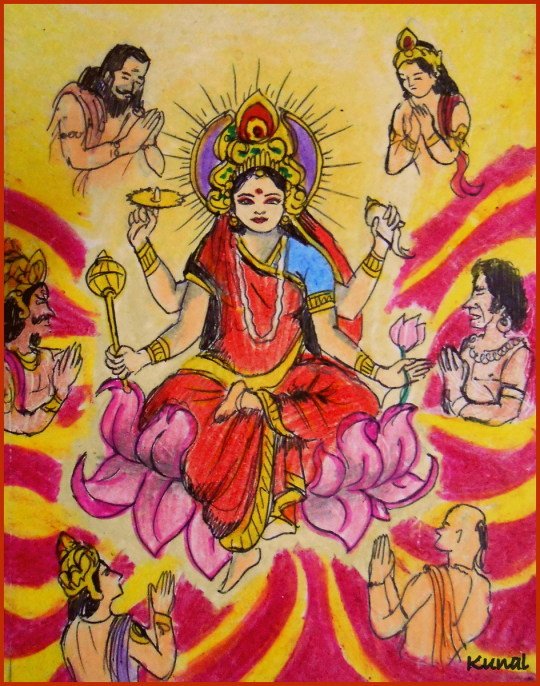
The ninth day of Navaratri celebrates Durga as Siddhidatri, the supreme goddess.
The colour of the day is purple and she connects us to the Universal Chakra, located above the Soul Star Chakra above the Crown.
She teaches divine knowledge, spiritual attainment and bestows all manner of siddhis (powers) to her devotees. Worship of her on this day is said to help one focus on higher attainment in all pursuits, whether those pursuits are physical or spiritual. She grants boons to mortals and spirits alike fulfilling the desires of her devotees. She promotes a mediative mindset, brings peace and helps one with devotional practices that take perseverance. She will even remove obstacles and fears, facilitate balance and perfection in all things, and bring success.
Her story goes as follows: When the universe was void and there was nothing at all to behold, a celestial light spread amongst the universe filling every part of the void. This light started to take shape into the form of Mahashakti. She brought into existence the trinity of gods; Brahma, Vishnu and Shiva. The Trinity of gods were then assigned their roles and obligations by the goddess. They then sat in meditation for a very long time performing many atonements, pleased with this the goddess appeared to them in her most divine form, Siddhidatri. She granted each of the Trinity all manner of siddhis, also gifting the trinity with their three wives, who all represent divine aspects of herself; Brahma with Saraswati, Vishnu with Lakshmi, and Shiva with Parvati, who are to help them with their tasks. She then goes on to create other deities, demons, universes, galaxies, worlds and life, and grants all manner of siddhis to anyone who dedicates their devotion to her.
✨Durga✨
✨Om Dum Durgayei Namaha✨
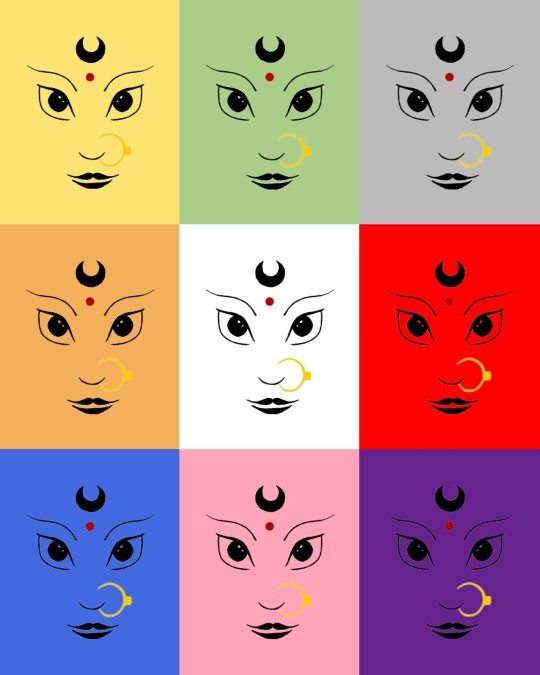
The tenth day of Navaratri celebrates all of Durga's victories over the past nine nights. Jai Durga Maa!
It is a tradition in some parts to commemorate the weapons and tools that brought Durga victory and triumph over all she faced, and too, pay homage to our own weapons, magickal or otherwise, and tools of trade that bring us victory in our own lives.
©️Sagans Sorcery 🔥🖋️
---
I have been posting each of her forms for each day during the festival on my Facebook page: facebook.com/SaganOakes
When I don't post on here I'm always posting there if you want to check it out 💙☄️
Thank you so much for reading ✨🙏✨ Much love.
While this article and the very last image I have used is written and created by myself @saganssorcery, the rest of the images I have found on the web. If you are the original creator(s) and wish for me to remove an image please send me a DM and I will remove it as soon as I see the message. Thank you 💙☄️
#durga#navaratri#spiritually#sagans sorcery#sorcery#sorceress#magick#occultism#occult#occult art#chaos witch#chaos magician#chaos magic#ceremonial magic#hindu art#hindu mythology#mythology#goddess durga#goddess worship#gods and goddesses#goddess#deity work#deity#deity worship#pantheon#witch#witchcraft#witch community#witchblr#witches of tumblr
20 notes
·
View notes
Text

-Chandraghanta
This day belongs to Goddess Chandraghanta, who is considered to be the Goddess of beauty and bravery. Her name Chandra-Ghanta, means “one who has a half-moon shaped like a bell. Her third eye is always opened and she always ready for war against demons”. She is also known as Chandrakhanda, Chandika or Rannchandi. She is believed to reward people with her grace, bravery and courage. By her grace all the sins, distresses, physical sufferings, mental tribulations and ghostly hurdles of the devotees are eradicated. Soon after Lord Shiva agrees to marry parvati, Shiva brings a procession of gods, mortals, ghosts, ghouls, goblins, sages, ascetics, Aghoris and Shivaganas to the gates of King Himavan’s palace to take away his bride Parvati, on the occasion of his remarriage. Shiva arrives at King Himavan’s palace in a terrorizing form and Parvati’s mother Maina Devi faints in terror. Parvati appears to Shiva and sees his fearsome form, so to save her parents and other family members she transforms herself into Goddess Chandraghanta. Chandraghanta persuaded Shiva to re-appear in a charming form. On listening to the Goddess, Shiva appears as a prince decorated with countless jewels. Parvati revived her mother, father and friends then Shiva and Parvati get married and made promises to one another. The devotees who adore and worship Chandraghanta develop an aura of divine splendor. Their persons emit invisible power-waves which exercise a great impact on those who come in contact with them. They easily achieve success in life. Chandraghanta is ready to destroy the wicked, but to her devotees she is a kind and compassionate Mother showering peace and prosperity.
credit
@zeherili-ankhein @no-idea-where-i-am-lost 3rd day!!
13 notes
·
View notes
Text
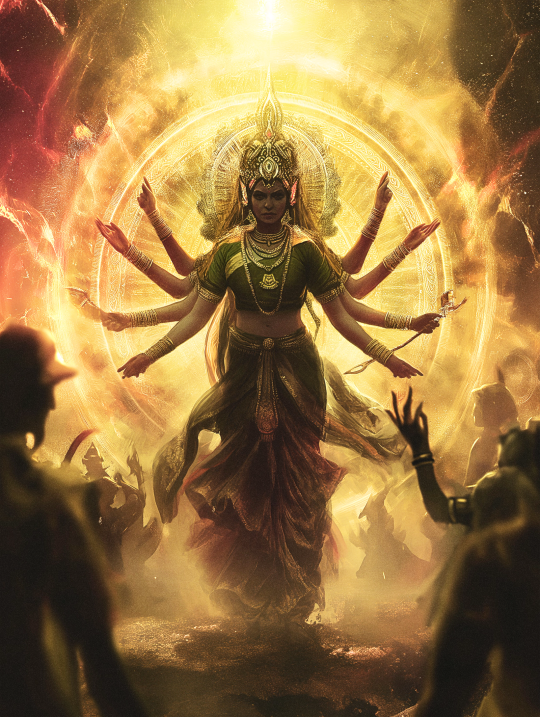
Maa Durga
Durga, in Hinduism, a principal form of the Goddess, also known as Devi and Shakti.
Happy Chaitra Navratri 2024!
Happy Chaitra Navratri 2024: The nine-day festival of Chaitra Navratri falls on April 9 this year. It will end with Ram Navami celebrations on April 17. Chaitra Navratri begins on the first day of the Hindu Luni-Solar calendar. Devotees worship Maa Durga and her nine incarnations - Maa Shailputri, Maa Brahmacharini, Maa Chandraghanta, Maa Kushmanda, Skanda Mata, Maa Katyayani, Maa Kaalratri, Maa Mahagauri and Maa Siddhidatri - on this day. They also worship Lord Ram on Ram Navami and celebrate his birth. --Krishna Priya Pallavi, Hindustani Times
26 notes
·
View notes
Text
Day three of Navratri
9 days, 9 Godesses

Day Three: Chandraghanta | चन्द्रघण्टा
Chandraghanta represents Parvati on her wedding day. Parvati was given this title by Mahadeva himself, due to her wish to have Chandra, the Moon God, adorn her forehead, as her Lord was adorned by the crescent moon upon his crown of matted locks, giving rise to his name Chandrashekhara.
Her fierce form is capable of destroying obstacles both on the inner path as well as the outside world. Her devotees easily achieve success in life. She bestows divine vision on them. Sometimes they hear divine fragrances and sounds.
Aum Devi Chandraghantaayai Namaha
ॐ देवी चन्द्रघण्टायै नमः
Jai Maa Durga 🔱
51 notes
·
View notes
Text
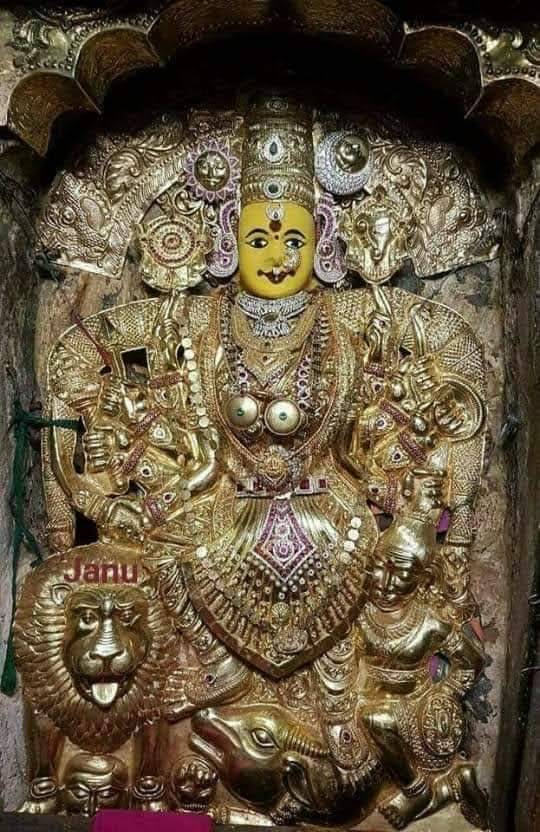
Fever Indrakshisthotram
This hymn is known as fever, recited for optimistic retirement and all epitome results, especially for the cure of fever diseases. The last seed letters in this need to be pronounced correctly by special feat, except just a hymn shared. Even if you recite this with devotion, there is a result. Interested people can ask their guru for a mantra along with alms.
The pre-design :
Asya Sri Indrakshisthotra Mahamantrasya,
Sachipuranda's Rishi, Anunthap Chandah,
Indrakshi Durga Deity, Lakshmir Beejam,
Bhuvaneshwarithi Shakti, Bhavanithi Kilakam,
Indrakshiprasadasiddhya means chanting viniyoga.
Karanya: -
Om Indrakshityangushtabhyam Namaha.
Om Mahalakshmithi Tarjanibhyam Namaha.
Om Maheshwarithi Madhyamabhyam Namaha.
Om Ambu Jakshityanamikabhyam Namaha.
Om Kathyayanithi minimum Namaha.
Om Kaumarithi Karathalakar Prushtabhyam Namaha ..
Structure: -
Om Indrakshithi hearty salutations.
Om Mahalakshmithi Sirase Swaha.
Om Maheshwarithi Shikhayai Vashat.
Om Ambujakshithi Kavachaya hmm.
Om Kathyayanithi Netrayaya Voushat.
Om Kaumarithi Astraya Phat.
Om Bhoorbhuvah Swarom Ithi Digbandah ..
Meditation -
Nethranam decade: Parivrutamathyugracharmambaram
Hemabham Mahatim delayed Keshanvitham.
Ghantamandita-Padapadmayugalam Nagendra-Kumbastanim
Indrakshim Parichintayami Manasa Kalpokta Siddipradam ..
Indrakshim Bibhujam Deveem with bracelet.
Vamahaste Vajradharam, South is the Varapradam..
Indrakshim Sahasrayuvathim Nanakara-Bhushitham.
Prasannavada Nambho Jampsarogana- Sevitham ..
Bibhujam Soumyavadanam Pashankushadharam Param.
Trilokyamohineem Deveemindrakshinamkeerthitham ..
Peethambaram Vajradharai Kastam Nanavidharanam Prasannam.
Swampsarasevitha-Padapadmamindrakshi Vande Shivadharmapatneem ..
Indradibh Surairvandyam Vande Shankarallabham.
Is Dhyatva Mahadevim Japeth selfishly ready ..
Gandham Samarpayami is the earthly soul.
Yes, the soul of the sky is the flower worshiper.
My Vaayavatma is the incense.
Rama Agnyatma is the lamp Darsayami.
Oh Amrutatma, Amrutam, Mahanaivedyam, Nivedayami.
The supreme court is the supremacy- Poojaam Samarpayami.
Pathu Chagneyyam Parameshwari, east of Vajrini.
Dandi is the south and the south is the sword.
Western Pashadhari's flag is hoisted by air-dimukhe.
Kaumodaki Thathodichyam Pathvaishanyam Maheshwari
Urdhavesh Padmini Mamadhastath Patu Vaishnavi.
Avam ten-disho Rakshet Sarvada Bhuvaneshwari
Indra Uvacha.
Indrakshi Nama sa Devi Goddess Sea Hrutha.
Gowri Shakambhari Devi Durga nomination rest
Salute to Nithyananda's homelessness.
Katyayani Mahadevi Chandraghanta Mahathapaha
Savitri Sa Cha Gayatri Brahmani Brahmavadini.
Narayani Bhadrakali Rudrani Krishna Pingala
Agni flame is a thunderstorm.
Meghasshyama's millennial Vikatangi Jadodari
Mahodari Muktakeshi is a horrible form of Mahabala.
Ajitha Bhadradananta Rogahartri Shivaprada
Shivaduti Karali's director - Parameshwari.
Indrani Indraroopa Ch Indrashakti Parayana
Always beautiful Bhuvaneshwari.
Single literate Parabramasthula Micro-Pravardini
Protector is like the blood of blood, malambara escaped.
Mahishasura-Hantree Chamunda sword bearer
Varahi Narasimhi Ch Bheema Bhairavanadini.
Shruti: Smritirdhrutirmedha Vidya Lakshmi: Saraswati
Anantha Vijayaparna, Manastoka Parajitha.
Bhavani Parvati Durga Haimavatyambika Shiva
Shiva Bhavani, Rudrani, Shankarardha-Shareerini.
Iravathagajaruda Vajrahasta Varaprada
Daily Sakala-Kalyani Sarvaishwarya-Prime Minister.
Dakshayani Padmahasta, all India
Kalyani is the birth of Durga is the destruction of Sarvadurga. (All sorrows are destroyed)
Indrakshi Sarvabhuteshi, all form of pleasure
Mahishamastaka- Dance-Entertainment- Explosion-Nupura-Paduka.
The victory of birth-protection-salvation starts-nishumbha-nishudini
Sarvamangala-Mangalya, Shiva is selfish-achiever.
Sharanye Trimbake Devi Narayani salutes
Guhyat-Cave-Gopthri Tvam housesmathkritam chanting.
Siddirbhatu May Goddess is fast
Fruitfulness
Narayana Uvacha ..
Praise the Lord Shakrena Dhimatha.
Ayurogya Maishwaryamaprithyu-Fear
Varam Pradanmahendraya Devarajyam Chaswatam.
Indrastotramidam is the sacred Mahadaishwarya-Karanam
Tuberculosis-Kushtadi-Tap fever-Raranam.
Thief-Vyagra-Dangerous-Vaishnava-Fever-Varanam
Maheshwaramahamari-Sarva fever-Varanam.
Cold-crazy-watadi-sarvaroga-runam ..
Disease arrested for century.
Frequency-Sahasratu is the result of the desired.
Indrakshim Natra suspects of Rajanam's sympathy.
We are the only water status, is it a thousand economics
Japeth praising mantram, reciting Siddirbhavedruvam.
Sayam Prathah Pathennithyam Shanma Sai is ready
Samvatsaramupashrithya is all ready.
Anena's fate devotee mantrasiddhi: people
Santushta Cha Bhavedevi is the real tradition.
Ashtamyam Chaturdashyamidam Stotram Pathennarah
Dhavatastasya Nashyanti is suspected of disruption.
Jail, Yada Baddho, Japeth will be held at midnight.
Divasatrayamatrena Muchyate Natra is doubtful.
Sakamo chanting hymns chanting mantra pooja
Panchadhikairdashadityarium siddisthu wins.
Blood pushpai blood cloth, blood sandalwood discussion. ೧೨..
Dhupadeepaishcha Naivedyai: Prasanna Bhagavati Bhaveth.
What is the Lord Indrakshimindrena .. ೧೩..
Varam Labdham Diteh Son Bhagavatyah Prasadataha.
Ethath Strotram Mahapunyam Japya Maushyavardhanam
Fever-Roganamaprityorharaya Ch.
Bijairnityamidam Japyam Bhagyaarogyamabheepsubhi
.. This is Indrakshi-Sthotram Purnam ..
3 notes
·
View notes
Text

@staff
Devi Chandraghanta name is derived from two words: "Chandra," which means moon, and "Ghanta," which means bell. She is often depicted with a crescent moon on her forehead and is known for wearing a bell-shaped ornament on her forehead or in her hair, hence her name.
2 notes
·
View notes
Text
Navadurga and significance of each day of Navratri
Devi is worshipped in 9 forms known as Navadurga. The significance of each day of Navratri is attached to a form of the Mother Divine.
First Day – Shailaputri

On the first day, Devi Shailaputri is worshipped. In this form, Devi Parvati is revered as the daughter of Himalaya Raja. Shaila means extraordinary or rising to great heights. The divine consciousness represented by Devi always surges from the peak. On this first day of Navratri, we propitiate Devi Shailaputri so that we may also attain the highest state of consciousness.
Second Day – Brahmacharini
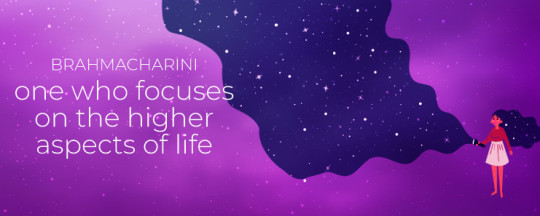
On the second day, Devi Brahmacharini is propitiated. Devi Brahmacharini is the form of Devi Parvati in which she undertook severe penance to have Lord Shiva as Her consort. Brahma means divine consciousness and achar refers to behavior. Brahmacharya is the behavior or an act that is established in divine consciousness. This day is especially sacred to meditate and explore our inner divinity.
Third Day – Chandraghanta
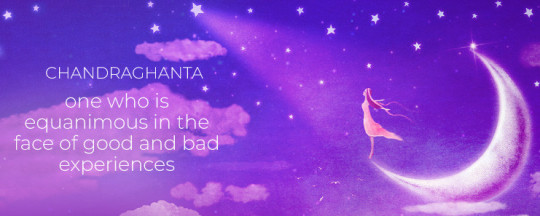
On the third day, Devi Chandraghata is the presiding Devi. Chandraghata is the special form that Devi Parvati assumed at the time of Her marriage with Lord Shiva. Chandra refers to the moon. The moon represents our mind. The mind is restless and keeps moving from one thought to another. Ghanta is a bell which produces only one kind of sound always. The significance is that when our mind is established at one point, i.e Divine, then our prana (subtle life force energy) gets consolidated leading to harmony and peace. This day thus signifies withdrawing from all vagaries of the mind, with a single focus on Mother Divine.
Fourth Day – Kushmanda

On the fourth day, Mother Divine is worshipped as Devi Kushmanda. Kushmanda means a pumpkin. Ku means little, ushma means energy and anda refers to egg. This entire universe which arose from the cosmic egg (hiranyagarbha) is manifested from an infinitesimal energy of Devi. A pumpkin also represents prana as it has the unique property of absorbing and radiating prana. It is one of the most pranic vegetables. On this day, we worship Devi Kushmanda who showers us with Her divine energy.
Fifth Day - Skandamata
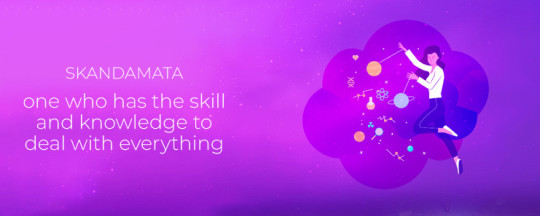
Skandamata means Mother of Skanda. On the fifth day, the motherly aspect of Devi Parvati is worshipped. In this form, she is the mother of Lord Karthikeya. She represents motherly affection (vatsalya). Worshiping this form of Devi brings abundance of wisdom, wealth, power, prosperity and liberation.
Sixth Day – Katyayani

On the sixth day, Devi manifests as Katyayani. It is a form that Mother Divine assumed to annihilate the demonic forces in the universe. She was born from the anger of the gods. She is the one who slayed Mahishasura. As per our scriptures, anger that supports dharma (righteousness) is acceptable. Devi Katyayani represents that divine principle and form of the Mother Divine who is behind natural calamities and disasters. She is the anger that arises in creation to restore balance. Devi Katyayani is invoked on the sixth day to put an end to all our inner foes that are an obstacle on the path of spiritual evolution.
Seventh Day – Kalaratri
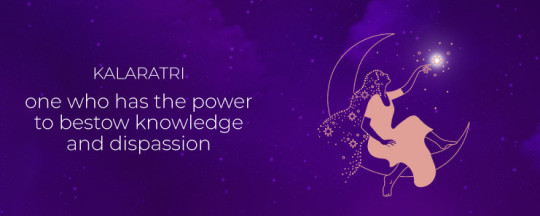
On the seventh day, we invoke Devi Kalaratri. Mother Nature has two extremes. One is terrifying and devastating. The other is beautiful and serene. Devi Kalaratri is a fierce form of Devi. Kalaratri represents the dark night. Night is also considered an aspect of Mother Divine as it is night that brings solace, rest and comfort to our souls. It is only at night that we get a glimpse of infinity in the skies. Devi Kalaratri is that infinite dark energy that houses innumerable universes.
Eighth Day – Mahagauri

Devi Mahagauri is that which is beautiful, gives momentum and freedom in life. Mahagauri represents the beautiful and serene aspect of Nature. She is that energy which propels our lives and also liberates us. She is the Devi who is worshipped on the eighth day.
Ninth Day - Siddhidatri
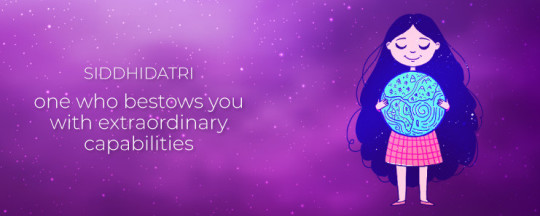
On the ninth day, we worship Devi Siddhidatri. Siddhi means perfection. Devi Siddhidatri brings perfection in life. She makes the impossible, possible. She takes us beyond the ever reasoning logical mind to explore the realm beyond time and space.
Jai Mata Ji!
4 notes
·
View notes
Text
Difference between Chaitra Navratri and Sharad Navratri
Reading time- 5 mins
India, a land of diverse cultures and traditions, celebrates Navratri not once, but twice a year with great enthusiasm and devotion. Navratri, meaning 'nine nights,' is a Hindu festival dedicated to Goddess Durga and her various forms. These two celebrations, Chaitra Navratri and Sharad Navratri, hold unique significance and are observed at different times of the year. In this blog, we'll explore why Navratri is celebrated twice in India and delve into the captivating mythological stories behind the divine forms of Maa Durga.
Chaitra Navratri: Welcoming Spring
Chaitra Navratri falls in the Chaitra month of the Hindu calendar, typically in March or April. This festival marks the beginning of spring when nature awakens, and new life blossoms. During these nine days, devotees pay homage to Goddess Durga and seek her blessings for prosperity and good fortune.
Chaitra Navratri is believed to commemorate the day when Lord Rama, accompanied by his brother Lakshmana and devotee Hanuman, worshiped Goddess Durga to seek her blessings before embarking on his epic journey to rescue his wife, Sita, from the demon king Ravana. It symbolizes the victory of good over evil and the triumph of righteousness. The culmination of Chaitra Navratri is celebrated as Ram Navami.
Sharad Navratri: Celebration of the Harvest
Sharad Navratri, also known as Maha Navratri, is the more widely celebrated of the two. It falls in the lunar month of Ashwin, usually in September or October when the monsoon season ends and the country gears up for the harvest season. This grand festival celebrates the divine feminine and the goddess's prowess in defeating the buffalo demon, Mahishasura.
According to Hindu mythology, Mahishasura was a formidable demon who terrorized the gods. He received a boon from Lord Agni, according to which a woman would only kill him. Unable to defeat him, the gods created Goddess Durga, a symbol of ultimate feminine power. Durga fought Mahishasura for nine days and nights, ultimately slaying him on the tenth day, known as Vijayadashami or Dussehra. Sharad Navratri symbolizes the victory of good over evil, knowledge over ignorance, and light over darkness. It is the ultimate celebration of divine female energies.
Young girls all over India are worshipped as devotees who believe that the Devi resides in little girls.
Maa Durga is depicted in 9 various forms, each with its own significance and attributes, to defeat the shape-shifting demon: Mahishasura. During Navratri, these forms are celebrated on specific days, known as 'Navadurga.' Let's explore some of the most renowned forms:
Shailaputri: The first form of Durga, she is the daughter of the Himalayas and represents the purity and innocence of nature.
Brahmacharini: She symbolizes the pursuit of knowledge and is often depicted holding a rosary and a water pot.
Chandraghanta: This form represents bravery and courage, as she adorns a crescent moon-shaped ornament on her forehead.
Kushmanda: The creator of the universe, Kushmanda signifies the source of all energy and vitality.
Skandamata: As the mother of Lord Kartikeya, she stands for the power of a mother's love and protection.
Katyayani: This fierce form of Durga is worshiped for her ability to destroy evil forces and protect her devotees.
Kalratri: Depicting the dark side of life, she is a symbol of destruction and liberation from ignorance.
Mahagauri: This form represents purity and is often depicted in white attire, symbolizing peace and serenity.
Siddhidatri: The final form of Durga, Siddhidatri is believed to grant devotees spiritual powers and enlightenment.
Navratri is a spiritually enriching festival that honors the divine feminine. Whether it's the arrival of spring during Chaitra Navratri or the harvest season of Sharad Navratri, both celebrations remind us of the importance of faith, perseverance, and the victory of good over evil. The diverse forms of Maa Durga teach us valuable life lessons and inspire us to live virtuously.
Gujratis celebrate Navratri through vibrant Garba and Dandiya Raas dances, while in Bengal, this festival is celebrated as Durga Puja, which involves worshiping the goddess Durga with grand processions and cultural events. So, they celebrate Navratri, but how it's celebrated varies.
This Navaratri, bring home the divine presence of Goddess Durga with the Navaratri-Durga Puja Kit from Prabhu Shriram- Incense with a Story.
This pack contains-
Mata Vaishno Devi Agarbatti
Upasana Dhoop
Sambrani Cups
Havan Samagri
Divya Jyot
Mauli Dhaga
Guggal Loban
Jau
Pavitra Ganga Sand Soil
Red Cloth
Mata Chunri
Laung
Supari
Sindoor/Roli
Haldi
Akshat
Mishri/Kaju/Kishmish/Elaichi
Camphor
2 notes
·
View notes
Text
Worship Maa Chandraghanta - Mata Annapurna Devi on the third day of Navratri

🌹 Worship Maa Chandraghanta - Mata Annapurna Devi on the third day of Navratri 🌹
Maa Chandraghanta is the third manifestation of Devi Durga and is worshipped on the 3rd of Navratri. Since she has a Chandra or half moon, in the shape of a Ghanta (bell), on her forehead, she is addressed as Chandraghanta. A symbol of peace, serenity and prosperity, Maa Chandraghanta has three eyes and ten hands holding ten types of swords, weapons and arrows. She establishes justice and gives Her devotees the courage and strength to fight challenges.
Her appearance may be of a source of power which is always busy killing and suppressing the bad and wicked. However, for her devotees, Maa is serene, gentle and peaceful. By worshipping Maa Chrandraghanta, you will open the doors to great respect, fame and glory. Maa also helps you attain spiritual enlightenment. Her idol, which symbolises both beauty and bravery, gives you the strength the keep the negative energy away and repels all the troubles from your life.
You need to follow simple rituals to worship Goddess Chandraghanta. You should first worship all the Gods, Goddesses and Planets in the Kalash and then offer prayer to Lord Ganesha and Kartikeya and Goddess Saraswati, Lakshmi, Vijaya, Jaya - the family members of Goddess Durga. The pooja should be concluded by worshipping Goddess Chandraghanta followed by a heartfelt prayer to Lord Shiva and Lord Brahma.
The Mantra And Other Facts About Maa Chandraghanta:
Maa Chandraghanta Dhyan: Pindaj Pravara Roodha Chand Kopaastra Kairyuta Prasaadam Tanute Mahyam Chandra Ghanteti Vishruta.
Maa Chandraghanta Mantra for the third day of Navratri:
Om Cham Cham Cham Chandraghantaye Hrum. (Chant 108 times).
Colour of the third day: White.
Prasad of the third day: Revdi i.e. mixture of white sesame seeds and jaggery.
Governing Planet: It is believed that the planet Shukra is governed by Goddess Chandraghanta.
Performing Shukra Grah Shanti Puja proves to be highly beneficial for the native on this day and helps to strengthen weak Venus in the birth chart. It helps you to attain health, wealth, and prosperity.
🌹 🌹 🌹🌹 🌹
#జ్ఞానవాహిని#Spiritual#Bhakthi#Insight#సందేశాలు#Jnanavahini#message of the day#Devi Navaratri#prasad bharadwaj
3 notes
·
View notes
Text
Day 3 of Navratri 2023: Exhibition III: Invocation to the Mother Goddess, Devi Durga through her aspect of Mother Chandraghanta - Half Moon Luminosity of Peace and Tranquility
he whole idea of celebrating Durga Puja 2023 which is now a UNESCO Heritage Festival in Bengal, was to go back and forth in time, to recollect art from the aborigines and tribes of Australia, India, South East Asia, Tibet and South America, Scandinavia and merge them into a new template based of pure non-dual consciousness where cinema, poetry, art, photography and other forms of self expression…

View On WordPress
#2023#artwork#beauty#being#biosphere#communications#culture#durgapuja#folk#frenchfasion#guitarist#humanity#Art#Consciousness#Divine Mother#fashion#Film#France#India#Tagore
1 note
·
View note
Text
Chaitra Navratri 2023: Rituals,Yoga, Days And Pujas To Perform
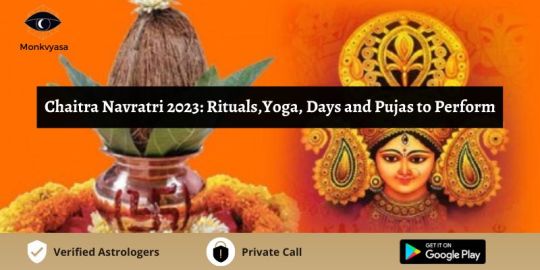
Navratri is a significant Hindu festival that is celebrated for nine nights on the Indian subcontinent during autumn. Traditionally, there are four seasonal Navratris, and the Sharada or Shardiya Navratri is celebrated after the monsoon season in remembrance of the Divine Feminine Devi. During this time, Hindus perform the customs and rites of Ghatasthapana and Sandhi Puja, which are considered to be the two most frequently observed muhurtas. Chaitra Navratri 2023 is particularly significant as it falls during the Shardiya Navratri, and Hindus observe the customs and rituals of Ghatasthapana and Sandhi Puja during this time.
The Navratri puja, also known as Vasanta Navratri, is a celebration that honors the sacred feminine Devi or Durga. Devotees worship and honor Divine Durga in her nine forms during this festival. The word "Vasanta" is derived from the Sanskrit language and signifies spring, which is when this Navratri occurs. It takes place during the Chaitra lunar month, which typically falls between March and April after the winter season. In some regions, this festival is celebrated after the spring season, while in others, it is observed after the harvest season. It is also significant as it marks the first day of the Hindu calendar, making it the Hindu New Year according to the Vikram Samvat calendar.
Chaitra Navratri 2023: Navratri days & pujas to perform
Here are the dates and details for Chaitra Navratri 2023:
Wednesday, 22 March 2023 (Pratipada): Maa Shailputri Puja and Ghatasthapana
Thursday, 23 March 2023 (Dvitiya): Maa Brahmacharini Puja
Friday, 24 March 2023 (Tritiya):Maa Chandraghanta Puja
Saturday, 25 March 2023 (Chaturthi): Maa Kushmanda Puja
Sunday, 26 March 2023 (Panchami): Maa Skandamata Puja
Monday, 27 March 2023 (Shashti): Maa Katyayani Puja
Tuesday, 28 March 2023 (Saptami): Maa Kalaratri Puja
Wednesday, 29 March 2023 (Ashtami): Maa Mahagauri Puja
Thursday, 30 March 2023 (Navami): Maa Siddhidatri Puja and Ram Navami
Friday, 31 March 2023 (Dashami): Navratri Parana
Chaitra Navratri is a festival where people worship the nine forms of Goddess Durga. They also try to find inner peace through meditation and seek happiness. During this festival, people also perform a ritual called Ghatasthapana or Kalash Sthapana. This involves setting up a sacred vessel for prayer. The Ghatasthapana Muhurta for Chaitra Navratri 2023 is from 06:23 AM to 07:32 AM.
Significance of Chaitra Navratri
Chaitra Navratri is an auspicious Hindu festival that commemorates the ultimate feminine form of the Hindu deity, Goddess Durga. She is regarded as Shakti, the most powerful feminine energy in the universe, and is worshiped with great devotion during this nine-day festival.
Navratri Puja is believed to bring immense wealth and fortune to those who seek the blessings of Goddess Durga. However, there are certain rules that the devotees must follow strictly, which include fasting without consuming grains, maintaining cleanliness, performing aarti and performing Ghatasthapana.
2 notes
·
View notes
Video
youtube
Devi Chandraghanta |कैसे माँ चंद्रघंटा ने महिषासुर के आतंक का किया अंत?#...
0 notes